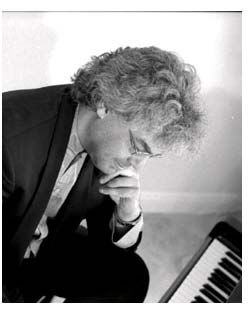2010 Performance by Bruce Lazarus
Benefit Concert by Bruce Lazarus
Thursday, April 29, 2010 at 7:00 pm
New School of Music, 25 Lowell St, Cambridge [directions]
A reception with the composer followed the performance
 |
In addition to Messier Catalogue of Star Clusters and Nebulae, Composer Bruce Lazarus’ most recent compositions include Regarding Eclipses for the NCFO Festival Chorus incidental music and songs for the Marymount Manhattan College production of As You Like It, and November Sonata for flute and piano. He studied composition at Juilliard with Vincent Persichetti and Andrew Thomas, earned his B.M. and M.M. in music composition, studied piano and composition privately with Donald Waxman, and later earned his PhD in music theory at Rutgers University. Lazarus is currently an Adjunct Assistant Professor of Music at Marymount Manhattan College and Music Coordinator for Mark Morris Dance Group. He may be contacted at brucelazarus2k@yahoo.com. |
Bruce Lazarus describes his music as "melodic, concise, driven, tart, at once neo-classical and exotic, subtly allied to jazz and rock, occasionally meditative but more often exuberant." Deeply interested in science, and astronomy in particular, he often gives his pieces titles such as StarSongs, Guide to the Winter Sky, and Alpha Centuri in an effort to convey his sense of connection to distant planets, stars, galaxies, and the universe.
Musical Explorations of Messier Star Clusters and Nebulae: An Astronomic Adventure for Solo Piano, is a continuing series of piano pieces based on the work of Charles Messier (1730-1817), a French astronomer who compiled a list of approximately 110 diffuse objects in the night sky. In Messier's day, these objects were often confused with comets, but they are now known to be nebulae, star clusters, galaxies, and immense patches of interstellar gas. Messier's catalog is still in common use today. Recent Hubble telescope photos of Messier objects reveal vistas of extraordinary beauty and also great variation in energy patterning – spiraling, floating, exploding, diffusing – which strongly suggest musical variations in rhythm, texture, formal design, and melodic elements.
Bruce Lazarus performed the first two books of Messier Catalog of Star Clusters and Nebulae, each describing seven objects:
Book 1
1. Messier 104 – Elliptical and Spiral Galaxy (“Sombrero” Galaxy) [Listen]
2. Messier 18 – Open Cluster with Red and Blue Stars
3. Messier 51 – “Whirlpool” Galaxy
4. Messier 1 – Expanding Remnant from Exploded Star (“Crab” Nebula)
5. Messier 57 – Ring Nebula [Listen]
6. Messier 45 – The Pleiades
7. Messier 31 – Andromeda Galaxy [Listen]
Book 2
1. Messier 40 - Double Star in Ursa Major
2. Messier 63 - Sunflower Galaxy [Listen]
3. Messier 42 - Orion Nebula [Listen]
4. Messier 16 - Eagle Nebula
5. Messier 24 - Star Cloud in Sagittarius
6. Messier 20 - Triffid Nebula
7. Messier 13 - Globular Cluster in Hercules
»



